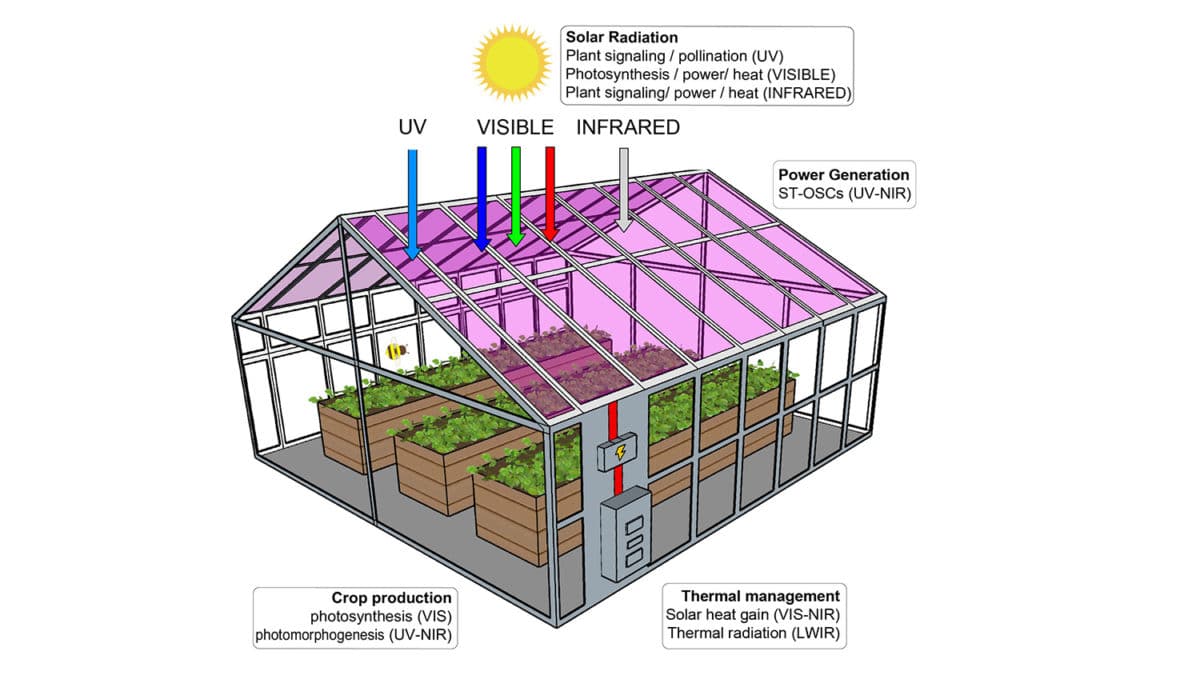Installing semi-transparent organic solar cells on the roof of a greenhouse requires a holistic approach that considers trade-offs between power generation, crop productivity, and greenhouse thermal management
This is the main conclusion of the study “Balancing crop production and energy harvesting in organic solar-powered greenhouses,” published in Cell Reports Physical Science and written by scientists at the North Carolina State University in the United States.
In the paper, the academics proposed to use semi-transparent organic solar cells that primarily absorb wavelengths of light that plants don’t rely on. Furthermore, these devices can help manage light transmittance from the ultraviolet (UV) to the infrared (IR), which has significant impacts on the thermal load of the greenhouse.
The scientists analyzed the growth of red leaf lettuce (Lactuca sativa) in a greenhouse equipped with organic solar cells coated with filters that can manage both near-IR (NIR) and long-wavelength (LW) IR. The filters were made with blend films such as FTAZ:IT-M, FTAZ:PC71BM and PTB7-TH:IEICO-4F combined with filters made of the conjugating-based polythiophene polymer PEDOT:PSS.
“The studies were conducted in a controlled environment growth chamber that allows for the comparison of plant growth and development under similar illumination, temperature, humidity, CO2 concentration, and water and nutrient supply,” the US group explained.
A control group of lettuces was exposed to the full spectrum of white light, while other lettuces were split into three experimental groups that were exposed to light through different types of filters. “The total amount of light incident on the filters was the same, but the color composition of that light was different for each of the experimental groups,” said research co-author Harald Ade. “Specifically, we manipulated the ratio of blue light to red light in all three filters to see how it affected plant growth.”
Popular content
The experiment showed that lettuce growth proceeded unabated under the solar cells, as the different transmission spectra had no impact on the fresh weight of the plants. “Furthermore, we show that the reduced light intensity reaching the plants reduces the rate of photosynthesis per area, but also increased the leaf area (LA) and leaf number, thereby minimizing the impact on crop yield,” the scientists affirmed. “These results demonstrate the possibility of successfully growing certain crops under semitransparent organic solar cells (OSCs) and highlight that a thorough characterization of crop production is needed to assess crop productivity.”
Their analysis also showed that the organic solar cells contribute to reducing overheating in the greenhouse. “We show that for a greenhouse in Sacramento, California, the number of hours that the greenhouse overheats can be reduced from 280 to 82 h,” they emphasized. “Lastly, using organic solar cell electrodes that can also function as low-emissivity coatings was shown to significantly reduce the heating load of the greenhouse.”
In a study published in February, the same research team said the use of semi-transparent organic solar cells could reduce the carbon footprint of greenhouses by powering the structures in warm and moderate climates. The North Carolina State researchers said semi-transparent cells on greenhouse roofs act as insulators as they reflect infrared light, helping keep the greenhouse warmer in winter and cooler in summer.
More recently, solar-powered greenhouses were developed by researchers from the University of Cambridge, scientists from Canada's Université de Sherbrooke, and Australian start-up ClearVue.
This content is protected by copyright and may not be reused. If you want to cooperate with us and would like to reuse some of our content, please contact: editors@pv-magazine.com.



By submitting this form you agree to pv magazine using your data for the purposes of publishing your comment.
Your personal data will only be disclosed or otherwise transmitted to third parties for the purposes of spam filtering or if this is necessary for technical maintenance of the website. Any other transfer to third parties will not take place unless this is justified on the basis of applicable data protection regulations or if pv magazine is legally obliged to do so.
You may revoke this consent at any time with effect for the future, in which case your personal data will be deleted immediately. Otherwise, your data will be deleted if pv magazine has processed your request or the purpose of data storage is fulfilled.
Further information on data privacy can be found in our Data Protection Policy.